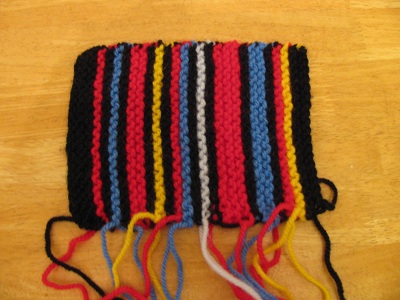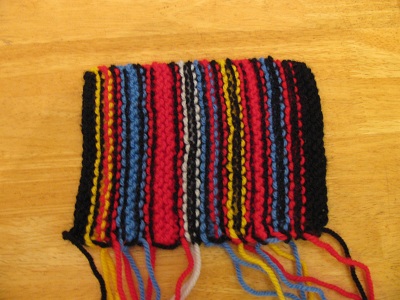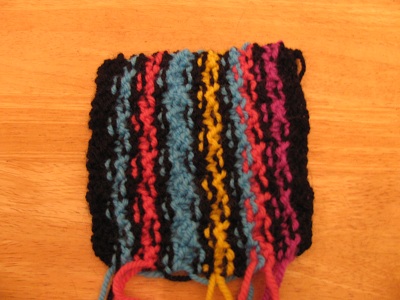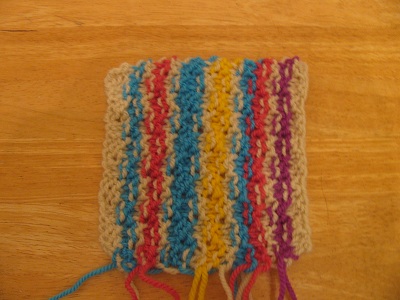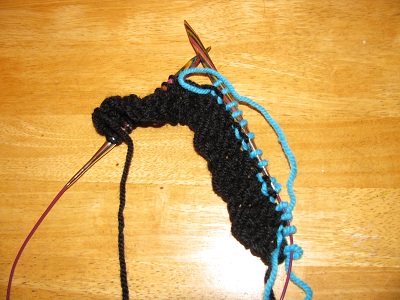I finished three swatches and decided on how I’m going to approach my new Prime Factorization Scarf.
First, I tried garter stitch. It’s a reversible stitch, and I thought it would work for the scarf. No pun intended, I thought I’d begin with the primary colors, since they are clearly “red,” “blue,” and “yellow.” Here’s how that swatch turned out:
The colors do stand out in this version. Black is 1, the background color. The pattern starts on the left. 2 is red. One ridge clearly stands out for the factor. When you get to 1 again, you stop multiplying and start a new number. Primes will always be one ridge. Next is 3, which is blue. Then comes 4, clearly showing as two ridges of red, 2 x 2. Then black, so you start a new number. Then comes 5, a new color, yellow. Then black. Then we have a ridge of red with a ridge of blue, 2 x 3 = 6. A ridge of black. Then 7, a new color. Black. Three ridges of red, 2 x 2 x 2 = 8. Black. Two ridges of blue, 3 x 3 = 9. Black. A ridge of red and a ridge of yellow, 2 x 5 = 10.
What I like about this swatch? The colors pop out and clearly show how many of each factor you want.
Problems with this swatch? Well, I completely forgot that garter stitch with colors is not reversible. Here’s the other side:
The garter stitch pattern would work great in a sweater, where you only see one side. But a scarf is better when it’s reversible, since it’s not easy to keep only one side of a scarf showing.
One other problem was that I didn’t like the colors. In the picture on the web, the red looked like a pretty cherry red. In real life, it was so bright, it almost glowed in the dark. Next to black, it feels glaring.
So I decided to experiment with the colors I think are the prettiest of all the ones in the box. After all, the color for 2 is going to get used in every other stripe. Might as well use a color I like to look at, right?
I needed to pick a stitch that would be reversible in color. I chose the Double Seed Stitch, which gives a nice textured look. You alternate two knit stitches with two purl stitches, and you do two rows that line up with each other. Then you do two rows with the stitches staggered from the first two — The knit stitches in the two top rows are lined up with the purl stitches in the bottom two rows, and the purl stitches in the two top rows are lined up with the knit stitches in the bottom two rows.
You can’t really tell the colors I used in the next swatch, but it’s a turquoise for 2 and pink for 3, yellow for 5, and purple for 7. I got happier and happier as I knitted. I think this is beautiful, and it will be the pattern I use for the scarf. Here’s that swatch:
Now, I acknowlege that it’s not nearly as easy to tell exactly where the numbers separate or exactly which factors are in the number. But it’s pretty. And I know which factors are where. And it’s completely reversible. The back looks exactly the same as the front.
I did one more swatch, to be absolutely sure I wanted to use a black background. I also wanted to see if using larger needles would make the fabric more drapey. The yarn band suggests size 8 needles, and that’s what I’d been using, and I think it would be nice for a sweater. But for a scarf, I’d like a little less firmness. So I made the next swatch with a cream-colored background and size 10 needles, but the same stitch and the same colors for the numbers. Here’s that swatch:
Yes, this combination is pretty. But I think it reminds me too much of my original prime factorization sweater, and I’m ready for something different. So I’m going to go with the black background.
So I’ve begun! I’m using Size 10 needles, a black background, double seed stitch, and 26 stitches across. (The swatches used 20 stitches.)
Oh, one more thing: I hereby resolve that I will, I WILL, sew the ends in as I go, so that I don’t have to do them all at the end, like I did with the sweater. (Sigh. The worst thing about this whole project!)
I also plan to make a black edging along the sides, to hide the carried-along yarn. I can practice on the swatches.
And while I’m knitting, my mind will be spinning with ideas for a cardigan.
Stay tuned and watch my progress! One of the fun things about it is that I can wait to choose colors as I go. I don’t even have to stop at 100….
My posts on Mathematical Knitting and related topics are now gathered at Sonderknitting.
